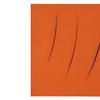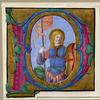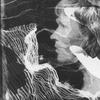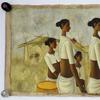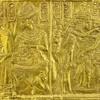Centre Pompidou Hosts National Gallery Singapore Exhibition on Modernist Latiff Mohidin
- SINGAPORE, Malaysia
- /
- March 07, 2018
Through May 28, Centre Pompidou in Paris hosts the National Gallery Singapore exhibition on a leading Southeast Asian modernist, part of the initiative 'Re-framing Modernism.'
As part of a new collaboration, the Centre Pompidou and the National Gallery Singapore are presenting an exhibition on the artist Latiff Mohidin, one of the key modernists of Southeast Asia. "Latiff Mohidin. Pago Pago (1960-1969)" is an extension of the innovative project "Re-framing Modernism: Painting from Southeast Asia, Europe and Beyond," co-produced with the Centre Pompidou and presented at the National Gallery Singapore in 2016, with a crossover approach to modern creation in Europe and Southeast Asia.
Commenting on the exhibition, Serge Lasvignes, President of the Centre Pompidou, emphasised that "'‘Latiff Mohidin. Pago Pago (1960-1969)’ is further proof of our desire to link up with major institutions all over the world. Our collaboration with the National Gallery Singapore on ‘Reframing Modernism’ was an important event for us, opening new perspectives on the dialogue of cultures. This new joint project gives our audiences a marvellous chance to see major works by a great contemporary artist from Southeast Asia, within the Centre Pompidou collections."
Dr Eugene Tan, Director of National Gallery Singapore said, “The Gallery’s curatorial efforts have sought to actively engage debates of modernism within a global context. The Gallery is delighted to continue this successful partnership with Centre Pompidou by presenting our first travelling show on Southeast Asian art. The exhibition showcases Latiff Mohidin’s art during the 1960s, which was a decade that marked such significant shifts both in Southeast Asia and Europe. Latiff Mohidin is not only one of Southeast Asia’s leading artists, it could be said that he is one of the first artists of the region to imagine ‘Southeast Asia’ as a distinct aesthetic realm. Curatorially, the Gallery continues to be driven by its mission in enabling a greater understanding of Southeast Asian art internationally.”
"Pago Pago: Latiff Mohidin (1960-1969)" is conceived by the curators Catherine David of Centre Pompidou and Shabbir Hussain Mustafa of National Gallery Singapore as a micro-history that situates one of Southeast Asia’s leading modernists in dialogue with his Western peers. Held in a space adjacent to the permanent galleries of the Pompidou, the exhibition is set in the 1960s when Latiff Mohidin embarked upon his formal study of art at the Hochschule für Bildende Künste in West Berlin from 1961 to 1964. Ranging from the emotional states of German Expressionism that Latiff Mohidin encountered during his formative years in Berlin to the ancestral imaginary of his rural upbringing in British Malaya, Pago Pago became a way of thinking manifested in a constellation of paintings, sculptures, prints poetry and writings.
In 1964, Latiff Mohidin returned to Southeast Asia from Europe with the hope of reengaging with a region that had been relegated to his subconsciousness. Amidst perceived communist expansionism in Vietnam and insurgencies that raged internally in Indonesia, Malaysia, Singapore, the Philippines and Thailand, he remained committed towards initiating his own sense of the region. If the Berlin years were about the ability to translate between cultures, the years that followed presented a different proposition: to think of all matter as eternal cycles. The poetry of the ‘Pago Pago’ years is in free verse form, while the paintings compositionally rely on thick outlines, controlled brush strokes, jagged and curvilinear edges. The exhibition will feature over 70 artworks and archival materials drawn from leading public and private collections in Singapore and Malaysia.
Mr Shabbir Hussain Mustafa, Senior Curator at National Gallery Singapore and co-curator of the exhibition adds, “This exhibition traces a formative period in the artist’s practice in the 1960s as he journeyed across Europe and Southeast Asia. Latiff Mohidin evokes the consciousness that emerged through these travels with a phrase: ‘Pago Pago’, a manner of thinking and working that complicated Western modernism through the initiation of dialogues with other avant-garde thinkers in Southeast Asia. These included the Indonesian writer Goenawan Mohamad, whom Latiff Mohidin first met in 1967. This exhibition will explore all sorts of interlocking connections in highlighting what constitutes a contribution to 20th century modernism.”
Ms Catherine David, Deputy Director, Musée National d’Art Moderne of Centre Pompidou and co-curator of the exhibition said, “This In-Focus exhibition is designed to unravel the complexities of key works that Latiff Mohidin produced in the 1960s, a decade which could be characterized as a moment when Southeast Asia established itself as a locus within the major redraft of Modernism. The exhibition concludes with the 1969 moment of Neo Pago Pago, a critical year in the artist’s practice as he transitioned from the Pago Pago series (1964-68) into a prolific output of literary prose and poetry, yet another understudied aspect of his practice that this exhibition will seek to tease out.”
A publication edited by the curators with critical articles on Pago Pago is being brought out at the same time as the exhibition.
Latiff Mohidin (b. 1941) is Malaysia’s leading modernist painter and poet. His passion for painting and drawing was evident at an early age, when he held his first exhibition at the Kota Raja Malay School in Singapore, to which he came to be identified as ‘the magical boy with the gift in his hands’. In 1960, he was awarded the Deutscher Akademischer Austauschdienst (DAAD) scholarship for his studies at the Hochschule für Bildende Künste in West Berlin, Germany. Upon his return to Southeast Asia in 1964, Latiff Mohidin embarked on an extensive journey into Indochina and the Malay world, establishing affinities and conversations with avant-garde artists and intellectuals of the time. He evokes this period through a phrase, ‘Pago Pago’, a mode of thinking and working that evokes the specificities of the region as aesthetic. This moment has found a significant place in writings on Southeast Asian art. In 1969, Latiff Mohidin was awarded the French Ministry of Culture Scholarship to study etching in Paris at the Lacou-rière-Frélaut, followed by the John D. Rockefeller III Grant for a residency at the Pratt Institute in New York in 1969. Latiff Mohidin has remained connected to leading figures in discussion about Southeast Asian aesthetics, through his conversations with thinkers such as Goenawan Mohamad, whom he first met in 1967.
As a poet, Latiff Mohidin’s artistic practice is also often linked to his literary activities. Like his art, his poetry is a methodological wandering that resists ideological or doctrinal writ. Rather, his anthologies offer an extended interrogation of the interior world of the artist. Many of these thoughts are reflected in GARIS Latiff Mohidin dari titik de titik (LINE Latiff Mohidin from point to point), a work of immense literary prowess that appeared in 1988, which grapples with the position of vernacular cosmopolitanism within the story of global modernism, which still considers Europe as its default. Much of Latiff Mohidin’s literary and painterly world is also informed by his readings of Jorge Luis Borges, Chairil Anwar and Johann Wolfgang von Goethe amongst others. Often breaking down disciplinary boundaries between the visual and literary, in 2012, Latiff Mohidin published his translation of Goethe’s Faust (Part 1), a figure that has fascinated him since his encounter with German literature in early 1960s. He first became recognised as a poet when he published his collection of poems Sungai Mekong in 1971, with the latest being Sajak-Sajak Dinihari (1996). Sungai Mekong has been translated into multiple languages, most recently into Spanish. Latiff Mohidin lives and works in Penang Island, Malaysia.







